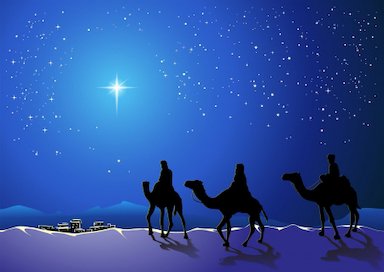Gospel Reflection: The Magi bringing gifts of gold, frankincense, and myrrh
/In he Gospel of Matthew (2:1-12) we learn of wise men or Magi that come from the East, guided by the star of Bethlehem, to pay homage to the newly born king of the Jews. When they find the home, guided by the star, they were overwhelmed with joy. Upon entering the house and finding Jesus with Mary they knelt down and paid respect in adoration. Then they opened their treasure chests and offered Jesus gifts of gold, frankincense, and myrrh. We celebrate this event every January 6th with the Feast of Epiphany, also known as Three Kings Day in many parts of the world. Epiphany comes from a Greek word that means manifestation. We celebrate the first manifestation of Jesus Christ to the Gentiles and the manifestation of his divinity and kingship. The Feast of the Epiphany is the 3rd oldest church feast after Christmas and Easter.
Who were these men and what is the significance of their visit? The Magi, which comes from the Greek magos, refer to a Persian priestly cast of Zoroastrianism, which became the main religion of Persia. They were astrologers, which at the time was considered an invaluable and highly regarded science. Over time they were also referred to as kings, although there is nothing in Matthew that identifies them as such. This description probably comes from an association to Old Testament prophecies that describe the Messiah being worshipped by kings (Isaiah 60:3, Psalms 68:29 and 72:10). In Puerto Rico, where I grew up, we called them “los Reyes Magos” or the Magi Kings. They have been referred to as kings since about AD 500.
In Puerto Rico everyone knows their names as Balthasar (a king of Arabia), Melchior (a king of Persia), and Gaspar (a king of India), countries within the Persian empire. This is of course based on tradition, but it is ancient tradition that came from a Greek manuscript composed in Alexandria around AD 500. While a lot of Christmas art show the three kings present, along with the shepherds, on the night of Jesus’ birth, they likely came to Bethlehem between one and two years later. That is why King Herod ordered all children in Bethlehem two years or younger to be killed.
Although God revealed himself to the Jewish people for over thousands of years and revealed the future coming of a Messiah, from the beginning God intended for salvation to be universal: for Jews and Gentiles alike. The Magi were the first Gentiles to recognize and pay homage to Jesus, who came to save all people. Such was their dedication to see Jesus, that they likely traveled from Persia, which is 1,600 miles from Bethlehem and likely took them 65 day on camels. Both shepherds, which were considered very low class, and these distinguished wise men came to Jesus and kneeled to pay respect. Are we equally as reverent to the real presence of Jesus in our tabernacles today? Do we kneel in adoration?
“The faithful of Christ venerate this most holy sacrament with the worship of latria which is due to the true God. […] For in this sacrament we believe that the same God is present whom the eternal Father brought into the world, saying of him, ‘Let all God’s angels worship him’ (Heb 1:6; cf. Ps 97:7). It is the same God whom the Magi fell down and worshipped (cf. Mt 2:11) and, finally, the same God whom the apostles adored and worshipped (cf. Mt 28:17)” (Council of Trent, De SS. Eucharistia, chap. 5, 1563).
What about the gifts? The gift of gold is obviously valuable today as it was then. But today we can easily buy frankincense for $14 a pound and myrrh for $19 for half a pound. It’s hard for us to appreciate, but in the first century frankincense and myrrh were as valuable as gold and presents fit for kings. Both were harvested from the sap of two trees, manually and painstakingly processed, and then transported via caravans from Arabia, Northern Africa, and India to far away destinations. Frankincense was used as a perfume, but also as an essential ingredient in the incense offering burnt for God in the holy of holies. Its use was mandated in the Book of Exodus. Myrrh was used for healing, but also as an embalming ointment and as a penitential incense in funerals and cremations. So from a symbolically spiritual perspective, gold symbolized kingship, Christ the king; frankincense symbolized deity and Jesus as high priest; and myrrh symbolized the suffering and death that Jesus was to endure out of love. The last verse of the Christmas carol “We three kings” says "Glorious now behold Him arise/King and God and sacrifice."
Like the three kings we are also asked to hear the call to seek Jesus and prostrate ourselves in homage in a spirit of surrender, surrender to do our king’s will. God called them through what they understood the most, a beautiful and bright star. Today he calls us through our vocation in life, such as homemakers, plumbers, and teachers. He calls us to follow his divine light and for us to shine that light onto others as bright as the star of Bethlehem. We are called to offer our treasures for the good of others out of love for Jesus.
“Let us remain in adoration; and to him, who, in order to save us, humbled himself to such a degree of poverty as to take our flesh, let us offer him not only incense, gold and myrrh (the first as God, the second as king, and the third as one who sought death for our sake), but also spiritual gifts, more sublime than those which can be seen with the eyes” St Gregory Nazianzen
Thanks for reading my blog and may God bless you and your family



